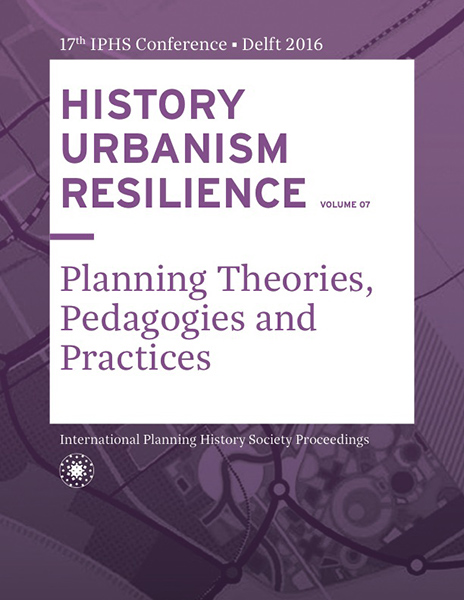Urbanisation and landscape juxtapositions in Minas Gerais, Brazil: revisiting historical cartographies
DOI:
https://doi.org/10.7480/iphs.2016.7.1336Abstract
The recent discussions following the biggest mining disasters in Minas Gerais bring to the fore the paradoxical relations between economical development versus ecological collateral damages of mining which are central in Minas Gerais, a state that carries mining in is name. The issue is of course embedded in the latent global debate that opposes development and environment. When radical soil transformations - including mining and urbanisation - are extensively performed in the name of development the question of social and ecological resilience becomes crucial.Since the eighteenth century colonial gold rush, urban and territorial development in the region, rich in gold and iron ore, has long been paired with topographical manipulations related to the extraction of these prime resources. These processes have created a landscape of addition and subtraction, where extraction becomes entwined also with the creation of urban fragments. Belo Horizonte, a city created from scratch in the end of the 19th century was no exception. To found the capital of Minas Gerais state, a territory of significant topographical features was soon confronted with the symmetrical array of perpendicular and diagonal streets proposed by the plan of 1895. Over its history, extreme manipulations of ground-surface conditions have not been limited to mining activities but are largely performed to allow urbanisation to take place in the form of heterotopic housing entities. Before the foundational grid had been fully laid out, its first metropolitan extension took place 12 quilometres from ground zero as a elite targeted satellite town around a new lake resulting from the damming of the river Pampulha.
The case of Pampulha is exemplary of the critical entwinement between enclaved settlement formation, artificial ground operations, water storage production and social-ecological resilience in Belo Horizonte, offering an inspiring terrain for re-imagining projectively the conflicts between human settlement and ecological cycles. By combining archival material with descriptive and interpretative mappings, this paper will address Pampulha’s emergence and historical development as the spearhead of the entanglement of enclaved urbanism and artificial topographies that is currently a dominant form of urbanisation in Brazil. Aiming to understand the complexity in the processes of transforming earth into land, territory is approached as a palimpsest, combining archival material with descriptive mappings done within the scope of the doctoral research. (Corboz 1983, Harley 1989)
References
Barreto, Abílio. Bello Horizonte: Memória Histórica E Descriptiva. Vol. 2: Imprensa Oficial Minas Geraes, 1928.
Burton, Richard. Viagens Aos Planaltos Do Brasil: Minas E Os Mineros. Companhia editora nacional, 1983. 1869.
Carsalade, Flavio de Lemos. Pampulha. Bh. A Cidade De Cada Um. Conceito, 2007.
Corboz, André. Deux Capitales Françaises: Saint-Pétersbourg Et Washington. Infolio, 2003.
———. “The Land as Palimpsest.” Diogenes 31, no. 121 (1983): 12-34.
Ferreira, Luana Maia. “As Várias Pampulhas No Tempo E No Espaço.” In Pampulha Múltipla, edited by Thais Pimentel. Belo Horizonte: AAMHAB, 2007.
Gomes, Maria do Carmo Andrade. “Aventura Cartográfica Na Cidade Nascente.” Revista do Arquivo Público Mineiro 46, no. 2 (2010): 16.
Gorelik, Adrián. “Ciudad, Modernidad, Modernización.” Universitas Humanística 56 (2003): 12.
Harley, John Brian. “Deconstructing the Map.”. 26 (1989): 1-20.
Hernández, Felipe, Mark Millington, and Iain Borden. Transculturation: Cities, Spaces and Architectures in Latin America. Rodopi, 2005.
Horizonte, Prefeitura Municipal de Belo. “Relatório Apresentado Pelo Prefeito OctacíLio NegrãO De Lima Ao Governador Benedicto Valladares Ribeiro Em 1935-1936.”. Belo Horizonte: Imprensa Official do Estado, 1937.
Lemos, Celina Borges. “A Cidade Republicana: Belo Horizonte, 1897-1930.” In A Arquitetura Da Modernidade, edited by Leonardo Barci Castriota, 310. Belo Horizonte: IAB-MG, 1998.
Martins, Jose de Souza. “The Hesitations of the Modern and the Contradictions of Modernity in Brazil.” Through the Kaleidoscope: The Experience of Modernity in Latin America. London: Verso (2000): 248-74.
Oliveira, Samuel Silva Rodrigues de. “A Identificação Das Favelas Em Belo Horizonte.” In XVII Simpósio Nacional de História, 2013. Natal: UFRN, 2013, 2013.
Plambel, Belo Horizonte. “O Processo De Desenvolvimento De Belo Horizonte: 1897-1970 “. Belo Horizonte, 1979.
Salgueiro, Heliana Angotti. Cidades Capitais Do Século Xix: Racionalidade, Cosmopolitismo E Transferência De Modelos. EdUSP, 2001.
Schelling, Vivian. Through the Kaleidoscope: The Experience of Modernity in Latin America. Verso, 2000.
Segre, Roberto. “Reflexões Sobre O Centenário De Belo Horizonte. As Duas Modernidades: De Aarão Reis a Oscar Niemeyer.” Anais: Seminário de História da Cidade e do Urbanismo 5, no. 2 (2012).
Tonucci Filho, João Bosco Moura. “Dois Momentos Do Planejamento Metropolitano Em Belo Horizonte: Um Estudo Das Experiências Do Plambel E Do Pddi-Rmbh.” Universidade de São Paulo, 2012.
Velloso, Rita de Cássia Lucena. “A Singular Insurreição Da Periferia.” In Democracia X Regimes De Pacificação. A Insistente Recursa Do Controle Exercido En Nome Da Segurança, edited by Leonora Corsini, 133-48. São Paulo: annablume, 2015.

